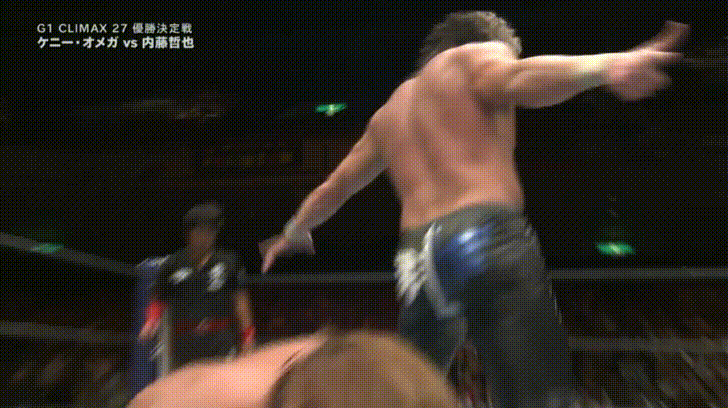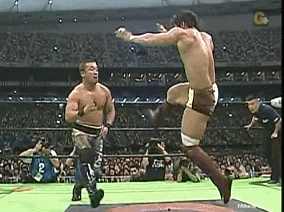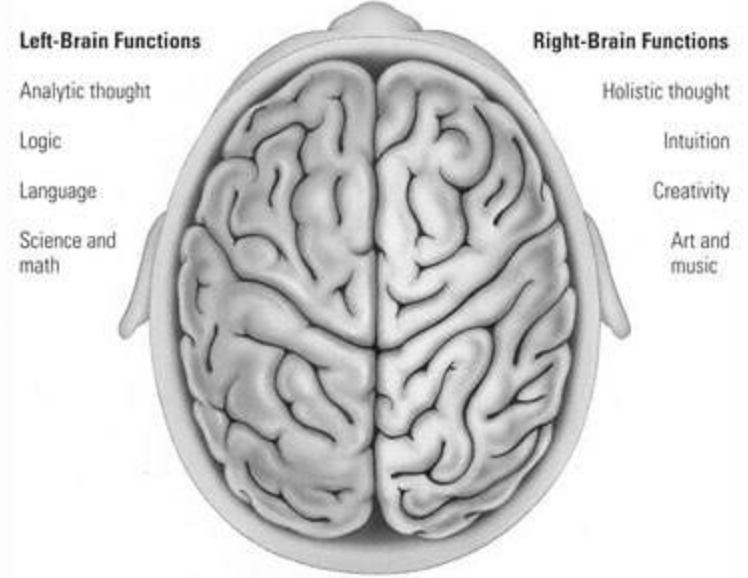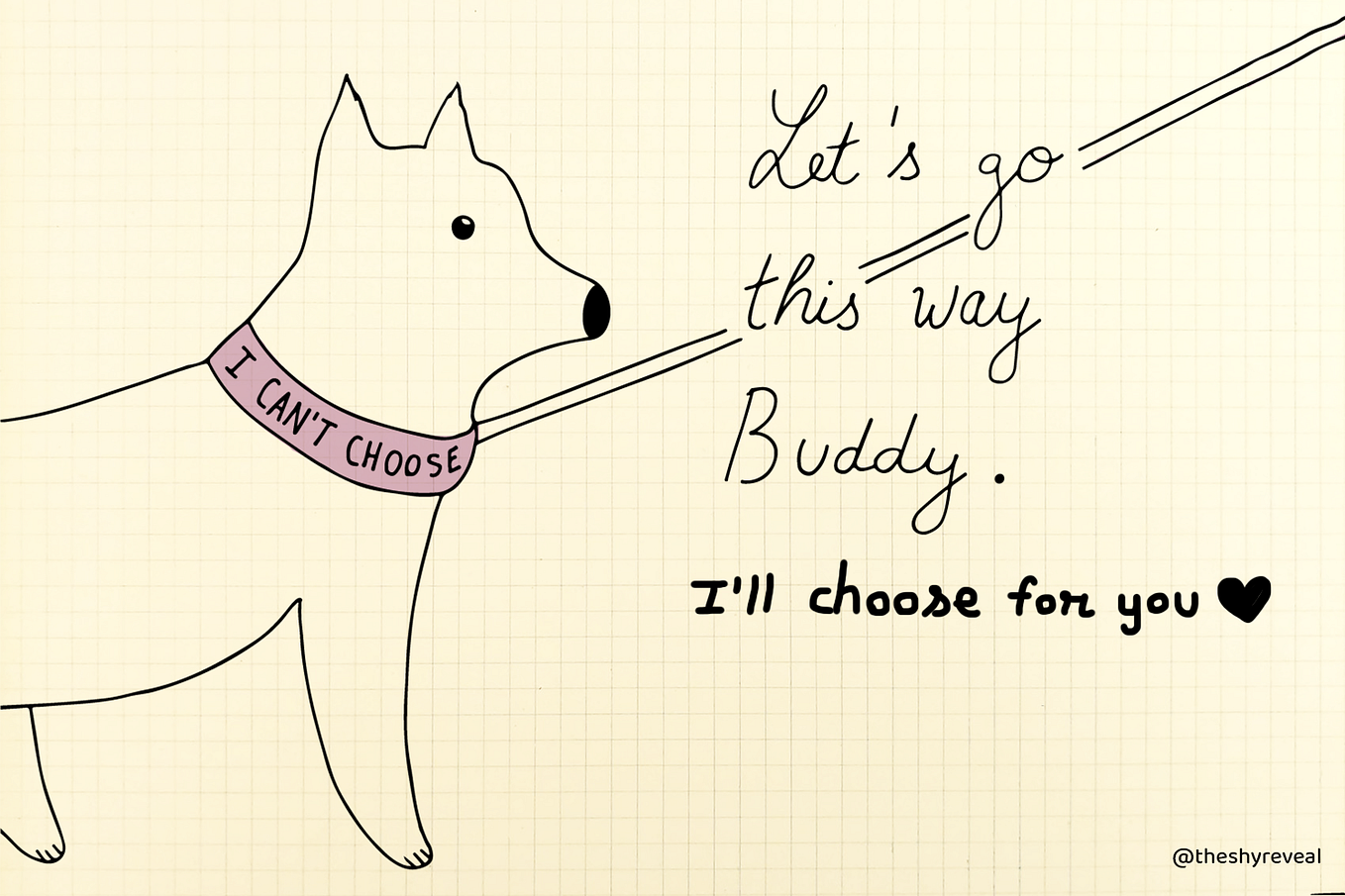The “Four Pillars” of All Japan Pro Wrestling have long been canonised — both in a literary and a religious sense — as the mythical figures who took pro wrestling to its artistic peak. Misawa, Kawada, Kobashi and (somewhat) Taue have had their matches and feuds consecrated by Dave Meltzer and the tape traders of the 1990s; their readers and successors, the hardcore fans of the internet wrestling community, have perpetuated this legendary status. It is difficult to deny that this treatment is richly deserved; the fantastic quality of matches, the long term storylines and the red hot crowds repeatedly packing out the Budokan all affirm the brilliance of the Pillars.
Yet as with any form where a canon of historical greatness develops, there are inevitably creators and works left outside it. The Four Pillars, and AJPW as a whole, cast a long shadow over the rest of the 1990s for committed wrestling fans, a shadow that eclipses the output of other Japanese promotions and wrestling stars during the period. Some of these oversights are understandable: Atsushi Onita, one of the most magnetic personalities in pro wrestling history, was plying his trade in his own sleazy promotion FMW, the kind of style that is rarely to the tastes of dedicated fans of Japanese wrestling. Wrestlers like Hayabusa and TAKA Michinoku have become cult figures for their innovative style and influence on the younger wrestlers of today, but would rarely be mentioned in the same breath as the Pillars. Shoot style promotions like UWFi, RINGS and PWFG remain particularly niche despite their quality and influence on modern mixed martial arts.
The canonisation of 1990s AJPW not only elevates one promotion and set of wrestlers, it also privileges a certain style of pro wrestling. The long-term storytelling of 1990s AJPW is often remarked upon as one of its greatest strengths, with subtleties that build over many years, observable as a reward only to the most attuned viewer. The Pillars are celebrated for their “epic” matches, bouts that would gradually build over a long runtime from initial exchanges to drawn-out, climactic finishing runs with escalating near-falls. This structure was highly praised and provides the blueprint for many modern big matches, in particular modern New Japan main events (albeit usually at a much higher pace.) Much like the greatness of the Pillars, the idea that main events must be a certain kind of “epic” — lengthy, competitive, with an extended finish — has been impressed upon many wrestling fans, whether consciously or unconsciously. Modern wrestlers, with the easy access to all kinds of wrestling that the internet provides, similarly display the influence of the Pillars and other Meltzer-approved wrestling in their matches nowadays.
Once again, this is not intended as a critique of 1990s AJPW or the Pillars, or necessarily the style itself. It is instead an acknowledgement that when certain wrestlers, promotions and styles are canonised in this way, those that do not fit the archetype will be less watched, less discussed and less praised. The idea of a literary canon has been criticised and deconstructed in more modern scholarship, as academics explore the ways in which it marginalises those literary voices that fall outside conventions of form, content, or social power and identity. This is not necessarily to draw a parallel between these struggles to be heard and the career of a particular wrestler, but I believe it provides a useful lesson on the problems raised by a pro wrestling canon, or by a few voices holding sway over critical opinion.
I have spent a long time explaining what I see as the elevation of 1990s AJPW, because I want to talk about a figure who achieved true pro wrestling greatness outside of that canonised promotion and style. He did not wrestle for AJPW until long after the split that saw three of the Pillars depart for Pro Wrestling NOAH (where he appeared only briefly, never wrestling a singles match against the top stars). He never received the coveted five star match rating from Dave Meltzer, and his CAGEMATCH profile has received only a fraction of the user ratings of Misawa, Kobashi or Kawada (although it maintains a very high average). Perhaps his most universally loved match lasted just under thirteen minutes. His greatest rivalries were developed in ugly slugfests and across shoots, worked shoots and everything in between, rather than layered epics. Yet in defying all these usual signifiers of pro wrestling “greatness”, Shinya Hashimoto carved his own path to becoming a legend; Meltzer, the man who underrated him critically, acknowledges that Hashimoto “along with Hulk Hogan, headlined more successful huge live pro wrestling events than any wrestlers in the history of the business”. In the process of becoming one of my favourite wrestlers, it is not an exaggeration to say Hashimoto changed the way I watch and appreciate pro wrestling.
When I first decided to write this piece, I was struck by how difficult I found it to begin describing what makes Hashimoto great. Hashimoto’s greatness is a rare kind: it is both immediately visible and tangible, something that can be experienced on the most instinctual level, and yet it is composed and replicated in the tiny minutiae and technical details of his professional wrestling. However, to try and scientifically describe, for example, the way in which Hashimoto uses kicks, feels like it is somehow reductive to his vast appeal. Likewise, I could spend an entire article trying to wax lyrical with different synonyms for Hashimoto’s “aura”, but I still might never come close to capturing the truth of it. It is certainly beyond my capabilities, and I suspect it may also be beyond those of much more talented writers, to try and capture the aura of Hashimoto in the English language. Cliches like having “it” or the dreaded WWE-esque “X factor” only gesture at Hashimoto’s essence.
I have perhaps also done Hashimoto a disservice by beginning my article with so much discussion of AJPW, because Hashimoto’s accomplishments and personality stand alone without needing a comparison to, say, Mitsuharu Misawa. This is doubly so because if one compares Hashimoto to Misawa on the basis of “great matches” or similar, Hashimoto seems to be found lacking. As pro wrestling fans, we are accustomed to comparing the greats by these certain kinds of metrics. Standout matches, satisfying and carefully developed feuds, longevity at a high level; these are the quantifiable (albeit tantalisingly subjective) ammunition for arguments and debates about pro wrestling in most corners of the internet. Hashimoto may hold the record for the most Tokyo Dome sellouts, but even that hugely impressive statistic is only a number when it comes to discussing greatness in a critical context.
With all that in mind, deciding to go ahead and detail what makes Hashimoto great may seem like a fool’s errand. My hope is that even in failing to capture Hashimoto’s greatness, I will in some way pay tribute to it; the kind of failure of language that Wordsworth or Keats admit in the face of the inexpressible sublime, except instead of brilliant Romantic poetry, it’s a Medium article about a tubby Japanese wrestler. Luckily, unlike the Romantics, I am aided and abetted by video footage and animated gifs, so my meagre descriptions need not stand alone in representing Shinya Hashimoto. For the qualities of Hashimoto that resist description, I will list some of my favourite matches at the end of the article (as well as throughout), in the hope that they can better illustrate what I talk about here. Perhaps the best place to begin is the place where first impressions of a wrestler are so often made: an entrance.
The above video shows Shinya Hashimoto and his tag partner, Takashi Iizuka, making their entrance in the Tokyo Dome on 4th January 2000 to face the team of Naoya Ogawa and Kazunari Murakami. The match itself can be viewed on Youtube in two parts here and here (Ogawa’s particular insistence on his matches being kept off World means it can only be pirated). The match may seem an odd choice for a demonstration of Hashimoto’s greatness; it is a tag rather than a singles match, it is stopped and restarted midway through, and Hashimoto is not directly involved in the eventual finish. However, I believe that the match, in all its molten heat and chaotic action, provides a perfect showcase of that instinctual greatness I mentioned earlier.
Hashimoto’s entrance brings an incredible sense of gravitas and spectacle to the match; right here, in the Tokyo Dome, the most fearsome warrior on the planet is about to do battle. The start of his theme, “Explosive Declaration”, turns the Dome into a cauldron of noise, with Hashimoto’s name reverberating around the inside of the arena. Hashimoto, for his part, barely acknowledges the crowd (aside from his simple hand gesture when he enters the ring); instead his eyes stay fixed straight ahead, resolute and seething with fighting spirit. His presence elevates the atmosphere and energy around the match to a tremendous level, and the match retains that feeling all the way through. The crowd is especially rabid whenever Hashimoto faces off with Naoya Ogawa, his career-defining rival and eventual close friend.
The match itself is chaotic, immediate and totally anarchic. Tag team rules are disregarded, the referee is thrown around, and the NJPW wrestlers at ringside pour into the ring to get stuck into the enemy. It takes the intervention of Inoki himself to restart the match, and then the chaos begins all over again. Perhaps the highest praise I can give the match is that it doesn’t feel like a wrestling match — it’s somewhere between an MMA fight and a prison yard brawl, all in front of a roaring crowd. Even the mat wrestling between Murakami and Iizuka is like a bar fight that spills onto the street outside, if the drunks were somehow expert submission wrestlers. There are moves and counters within the match, used well, but they are all in service of something less concrete and more pervasive. It is the pro wrestling equivalent of a Kandinsky painting, where the forms themselves are less important than the feeling of urgency, anger and desperation. Even the traditional start and end of a wrestling match are subsumed by the restart and the ongoing brawling after the “finish”.
This match, and Hashimoto’s longer, one-sided feud against Naoya Ogawa, illustrate just why he profiles so differently to the Pillars, and differently to the usual measures of pro wrestling “greatness” as defined by their work. The feud and the matches were fractured and untidy, even spilling over the boundaries of pro wrestling in the grim shoot beating that became known as the “January 4th Incident”. There was no cathartic redemption for Hashimoto, as Ogawa eventually “retired” him in their last match against each other. Ogawa was never very technically capable — although he had charisma to spare — and none of their matches exceeded fifteen minutes. Rather than epic contests to be the standard bearer for the promotion, theirs was a feud build on rage and revenge, and this demonstrates Hashimoto’s most significant difference from the style of 1990s AJPW. Rather than precise structure and start-to-finish storytelling, Hashimoto’s matches were all about emotion and energy — passion, fire, hatred, courage, even disappointment and tragedy. That is not to say that the best AJPW matches lacked for these; I have watched enough Kenta Kobashi to know that. Yet “energy”, although it is nebulous, feels like the best way to describe what elevates a match like the aforementioned Ogawa tag to that level, when it is executed so differently to the AJPW epics.
Of course, the brilliant details in Hashimoto’s work were crucial in maintaining that energy, but so much of the work was done by his unmistakable aura, which turned into a simmering sense of constant danger within the matches themselves. I am wary of veering into triteness and cliche, but Hashimoto felt like a modern day samurai, epitomising pride, courage and the fighting spirit so often invoked when discussing Japanese wrestlers. Hashimoto felt traditional yet also timeless, right down to the hachimaki he wore on his head on the way to the ring (and would tear off when it was time to fight, a wonderful little gesture). His was the kind of aura that could instantly command respect and give the audience something to fixate upon, against any opponent and no matter the odds.
Even if it is difficult to describe, I felt it important to write about Hashimoto’s aura as best I could, because it is the first thing one notices about him, and what drew me and many others to his work — not to mention the legions of paying fans it drew as well. It should be no surprise that Hashimoto both set the record for number of Tokyo Dome sellouts and earned a reputation as a fantastic “big match” wrestler. Hashimoto’s remarkable ability to fill any arena with his energy and intensity meant that he never seemed dwarfed by the grandeur of Japan’s largest wrestling venue, and his ability to maintain that intensity throughout a match resulted in contests that felt suitably titanic. Hashimoto was a huge factor in creating the feeling of a “big match”, hence he was perfectly suited to performing in them in front of massive crowds. Yet one of my favourite Hashimoto appearances is his NWA World Heavyweight Title match against Steve Corino in 2001, after he had left NJPW. In front of a tiny crowd in a pokey Florida gym, about as far removed from the grand stage of the Tokyo Dome as you can get, Hashimoto’s aura and presence still seems to command respect.
When I first saw this Hashimoto performance, as the regional crowd throws out a few vaguely offensive heckles (“this ain’t sumo wrestling, Hashimoto”) and he circles the bleached blonde Corino, I remember being struck by just how dignified and noble Hashimoto appeared. He is so far removed from the glory of the arenas he made his own, yet he brings that same immutable energy with him. That energy could elevate all kinds of opponents or environments; interpromotional wars against Genichiro Tenryu, Tokyo Dome main events against Naoya Ogawa, or even this regional title match with an ex-ECW wrestler felt like the biggest matches on the planet when Hashimoto was a part of them. Hashimoto may not have had the technical quality of opponents of Kawada, Misawa, Kobashi or Taue (who of course benefited from wrestling each other), but his ability to elevate a match with just about anybody meant that he had memorable matches with a very wide range of opponents and styles.
In choosing to compare Hashimoto thus far to the Four Pillars — even for the sake of contrast — I have been guilty of omitting his own closest contemporaries: the other two of the “Three Musketeers” of NJPW, Keiji Mutoh and Masahiro Chono. The truth is that I find them a somewhat awkward comparison for Hashimoto, and a far less interesting one than the AJPW greats; their appeal feels very different to Hashimoto’s. I have never particularly liked the ring work of either (especially Mutoh), and therefore I feel a detailed comparison would be beyond me. However, I take issue with the contrast often drawn between Hashimoto and the other two: the idea that they had “more charisma” to make up for other shortcomings. Charisma is a woolly term, especially when applied to wrestling.
However, I have always tried to see it in simple terms: the connection a wrestler can forge with their audience. This is not to say that Chono or Mutoh lacked charisma; Mutoh’s iconic status and Chono’s ability to remain extremely popular while physically limited are proof enough of that. Yet to me, Hashimoto’s connection to the crowd had a kind of absolute sincerity and directness to it, which speaks to me strongest out of the Three Musketeers. Hashimoto was not “cool” in the usual sense, nor was he exotic or mysterious like Muta. He was simply an incredibly courageous warrior, brave yet mortal, who would not back down from any challenge and fight to the last. That simple character has been imitated endlessly throughout the history of pro wrestling — it is the quintessential babyface character — but when you can convey it as flawlessly as Hashimoto, you need no accessories. Hashimoto was also able to invest that character with remarkable depth: he would show a hot-headed disregard for the rules, or frustration at being bettered, both of which felt like natural extensions of that stubborn warrior character without making him less likable. In that sense, although Hashimoto’s charisma takes a different form, I find him just as charismatic as Mutoh or Chono, if not more.
As I have said, in his actual wrestling — insofar as one can exclude entrances and the crowd from “wrestling”, which is a somewhat vain effort — Hashimoto was able to turn his gravitas into a constant sense of danger and struggle. This feeling was there in the physical details of Hashimoto’s work: the way he moved around the ring, the way he closed space on his opponents, and the superb facial expressions he used to show focus, pain or exhaustion as the match demanded it. Hashimoto struck an impeccable balance between toughness and vulnerability that was fundamental to his matches. He was an indomitable warrior with an almost bottomless reserve of fighting spirit, yet he could still be plausibly defeated by a dangerous opponent. This balance, when executed correctly, is the ideal formula for a pro wrestling babyface, drawing the audience’s sympathy while still maintaining their heroic appeal. Hashimoto’s appearance aided that balance; he was not a monster that towered over opponents (with a few exceptions, such as his superb David vs Goliath match with Jushin Thunder Liger), but he was chunky enough that you could easily believe him being tough to knock down. Rather than just standing there and taking his opponent’s offence, he was a convincing obstacle to both strikes and holds.
Two matches spring to mind to showcase the way Hashimoto balanced toughness and vulnerability, as well as to display his great aptitude for the all-important sense of struggle. In his 1994 defence of his IWGP title against Hiroshi Hase, Hashimoto is forced to deal with the challenger’s dedicated grappling approach; Hase constantly shoots in for takedowns, looking to ground the champion and apply some of his impressive technical skill on the mat. Although Hashimoto is outmanoeuvred on the ground — he is not without weaknesses — he resolutely defends Hase’s matwork, always struggling to deny Hase’s slick transitions and holds and improvise holds of his own. Eventually Hase grows frustrated with his lack of success, slaps Hashimoto and gets drawn into a striking battle, where Hashimoto reigns supreme; despite a thrilling rally from Hase at the last, Hashimoto retains his title after a sequence of devastating moves. That feeling of the match being a struggle — of Hashimoto making his opponent work, and having to work himself to find openings — always upped the stakes of his matches. It felt important whenever an opponent got the upper hand over Hashimoto, and Hashimoto would look to press his advantage when he had the momentum.
The second is the 1998 G1 Climax final, where Hashimoto, in pursuit of the G1 title that had eluded him his entire career, faces off against the shoot stylist Kazuo Yamazaki. Yamazaki comes in as the underdog, but he comes prepared, relentlessly targeting Hashimoto’s already injured leg with low kicks and his dangerous submissions; like Hase, he knows he can’t beat Hashimoto going blow for blow. As the match wears on, and Hashimoto becomes less and less likely to throw his signature kicks, his vulnerability becomes more and more evident and the drama grows and grows. Hashimoto is forced to overcome not just his opponent, but the limitations of his own body. It is a minimalist match, based mainly around strikes with a few surprising big moves thrown in, but the beautiful details of Yamazaki’s strategy and the way Hashimoto reacts turn it into a masterpiece. One of my favourite moments from the match is shown below, one that sums up Hashimoto as a wrestler: down to one knee and nursing his bad leg, he still seizes the chance to deliver a blistering chop and knock Yamazaki down. There are few better illustrations of the way Hashimoto could draw the sympathy of any audience, while still remaining the most dangerous man around.
Hashimoto married his excellent selling and sense of struggle to an explosive offence, which played perfectly in the big matches and arenas he made his domain. Hashimoto did not have an especially big moveset but he used his moves to their full potential. His strikes, from his iconic kesagiri chops to the range of kicks he used so well, had a real force behind them befitting of his substantial frame. When Hashimoto turned to submissions, he applied them quickly and purposefully, without any flash. His DDT, whether standing or running, always looked brutal as Hashimoto would throw his full weight into the move, wrenching his opponent down with him headfirst. His brainbuster has never been bettered and probably never will be.
All of Hashimoto’s offence looked strong, yet it was not just the attacks he used but the way he used them that made them so impactful. The way Hashimoto would build anticipation then let rip with a burst of his brutal offence is like watching a volcano rumble and then erupt, and the spectacle is similarly frightening and awesome in equal measure. Building up tension and then releasing that tension is fundamental to professional wrestling — to all drama, really — and Hashimoto was a maestro at this. Watching Hashimoto wrestle, waiting for the explosion, reminds me of how the philosopher Simon Critchley describes watching a football match in his book What We Think About When We Think About Football:
“We watch and we are drawn into the game, captivated, attentive and… pensive, thoughtfully attentive in a very particular way. We watch in the moment and we await that moment of moments when something extraordinary happens.”
In his 1996 G1 Climax match against Riki Choshu — a tremendous contest overflowing with emotion and drama — Choshu backs Hashimoto into the corner twice after getting the best of their initial lock-ups. Out of frustration, Hashimoto delivers a couple of stinging kesagiri overhand chops as warning shots, to the excitement of the crowd.
Later in the match, Choshu corners Hashimoto again and works him over with strikes; this time, Hashimoto explodes out of the corner, unloading overhand after overhand and forcing Choshu into the opposite corner, where Hashimoto stomps on him and yells in exhilaration. And naturally, the crowd reacts the same way, roaring at seeing Hashimoto’s constant dangerous energy turn into actual violence. These two sequences are brilliantly twinned within the match, teasing and then recalling one another, but on a simpler level they are a perfect demonstration of how thrilling it is when Hashimoto lets loose with his offence. In both cases, seeing Hashimoto erupt is enough to tangibly change the dynamic of the match.
The way Hashimoto utilised his kicks is also a great demonstration of his ability to escalate a match. Hashimoto could use his kicks as a frequent strike, working over opponents and making up the body of a match, yet he could also use a single kick as a crucial move that turns a match on its head. I am particularly fond of this fantastic moment from his match with Genichiro Tenryu from 1994. Tenryu brushes Hashimoto’s face with taunting kicks, bounces off the ropes, attempts a lariat and Hashimoto takes it in stride. There’s a pause, a swell of anticipation, and Hashimoto buries a kick in Tenryu’s midsection that folds him in two. It is perfectly timed and placed, and conveys so much about Hashimoto with a single strike, while changing the dynamic of the match: now Hashimoto is the one stomping away at his downed opponent. Hashimoto’s brilliance shines through in these moments where he can make a single kick mean so much, and change a match at the drop of a hat.
Hashimoto was a genius at signalling these changes whether selling, going on offence or anything in between, like the way he spat in the face of Victor Zangiev in their remarkable 1989 match. This quality of Hashimoto’s is one of his greatest, and also, infuriatingly, maybe the most resistant to description. He had an innate ability to escalate a match, to suddenly ratchet up the drama and excitement, to change the way it felt, in a totally natural way. It is so hard to describe because it is an instinctive sensation, much like the aura Hashimoto created for himself. Again, I could resort to cliches about the “big fight feel” or similar, but they do not come close to the feeling of watching Hashimoto do something, or react in a certain way, and knowing “it’s on now.” When a Hashimoto match changes like this, I am once again reminded of Critchley discussing “that moment of moments”:
“At such moments of moments, we are somehow lifted up, elevated. We try to catch our breath. “It is happening”, we whisper to ourselves. What we have here is what James calls one of the holidays of life, something like an experience of enchantment, where we are lifted out of the everyday into something ecstatic, evanescent and shared, a subtly transfigured sensorium.”
That shared, instinctual experience is fundamental to pro wrestling. There is the sense of the match shifting gears, a quickening of the blood. A wrestling match can often feel like a piece of music, with the way it relies on pacing, intensity, and the noise of the crowd to accompany it. Shoot style is famous for its unusual pacing; like a symphony suddenly becoming very loud, bursts of action arrive and depart just as quickly, often many times throughout the course of a match. NJPW’s current style relies on a gradual crescendo for the big matches, as they and the crowd grow in intensity over the duration to reach a peak in the final minutes.
By contrast — both to its current style and to the style of classic AJPW — 1990s NJPW would often slowly build tension, suddenly explode into life, and then finish decisively and quickly. This style is firmly at odds with the “traditional” pro wrestling epic, with its back-and-forth and long finishing runs. It was the kind of structure one would rarely see out of AJPW in its heyday (without wanting to stereotype the output of a whole promotion), and there was a sense that any move could turn the match decisively. Hashimoto, however, mastered this style and pacing; it suited him perfectly. With his constant aura of both danger and vulnerability, and his ability to make wrestling moves mean so much, Hashimoto both created and fed off that atmosphere.
In ending up back at discussing Hashimoto’s “aura” and “atmosphere”, I have somewhat unwillingly summed up my feelings on what makes him so great. I have glossed over his flaws — of course he had bad matches and performances — but his strengths outweigh them massively, and it is much more fun to talk about those. I could rewatch hours of footage of Hashimoto, plucking out clip after clip to demonstrate just how good he was at the tiny details, but the fact remains that he is a wonderfully simple pro wrestler to understand on sight alone. He could make a match, a feud or an opponent feel special and important, and then have the ideal match to get the most out of that atmosphere. He was impossible not to root for, an indomitable warrior who was still wonderfully and tragically mortal. He feels like he belongs to a bygone era, yet his fire is timeless.
Hashimoto has not been canonised alongside the Pillars of AJPW, and he may never be written about in newsletters and messageboards, those narrow barometers of pro wrestling opinion. Yet even without those accolades, perhaps that is a fitting fate, because his brilliance stands out all by itself. Hashimoto blazed his own path to greatness, and along the way, he wrote his own legend.
Shinya Hashimoto vs Victor Zangiev, 24/04/1989
Shinya Hashimoto vs Genichiro Tenryu, 17/02/1994
Shinya Hashimoto vs Jushin Thunder Liger, 24/02/1994







